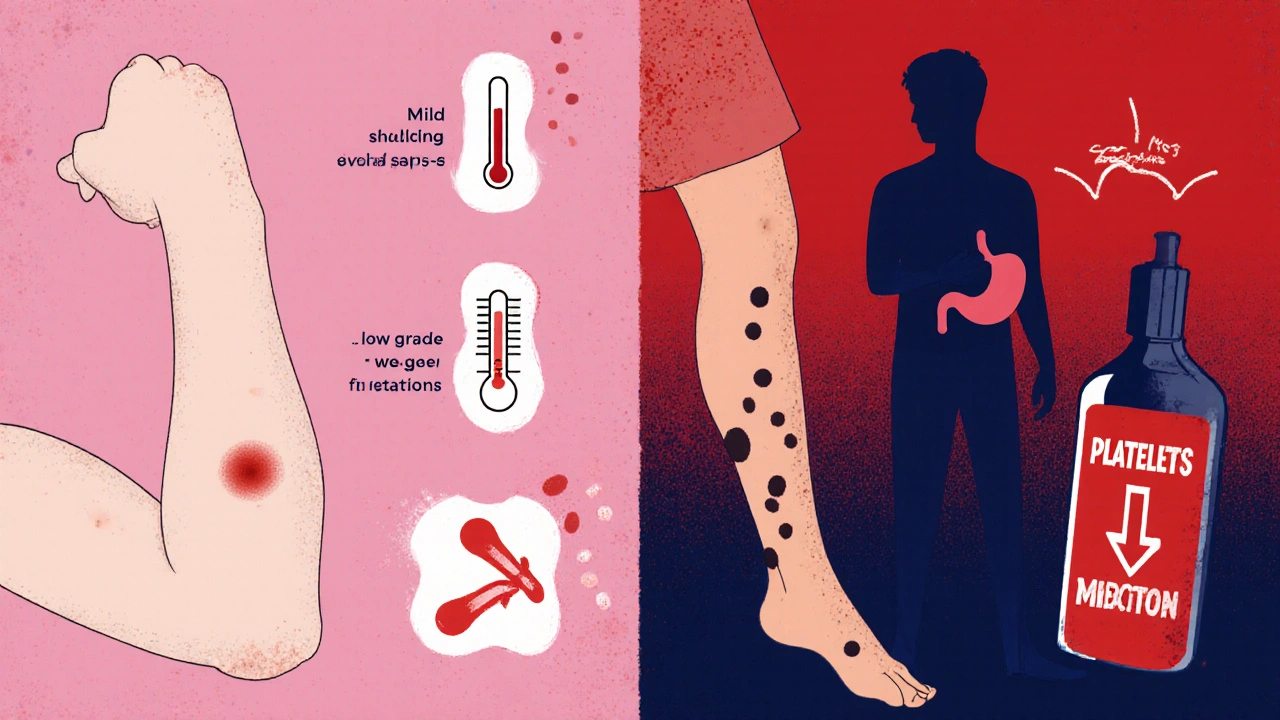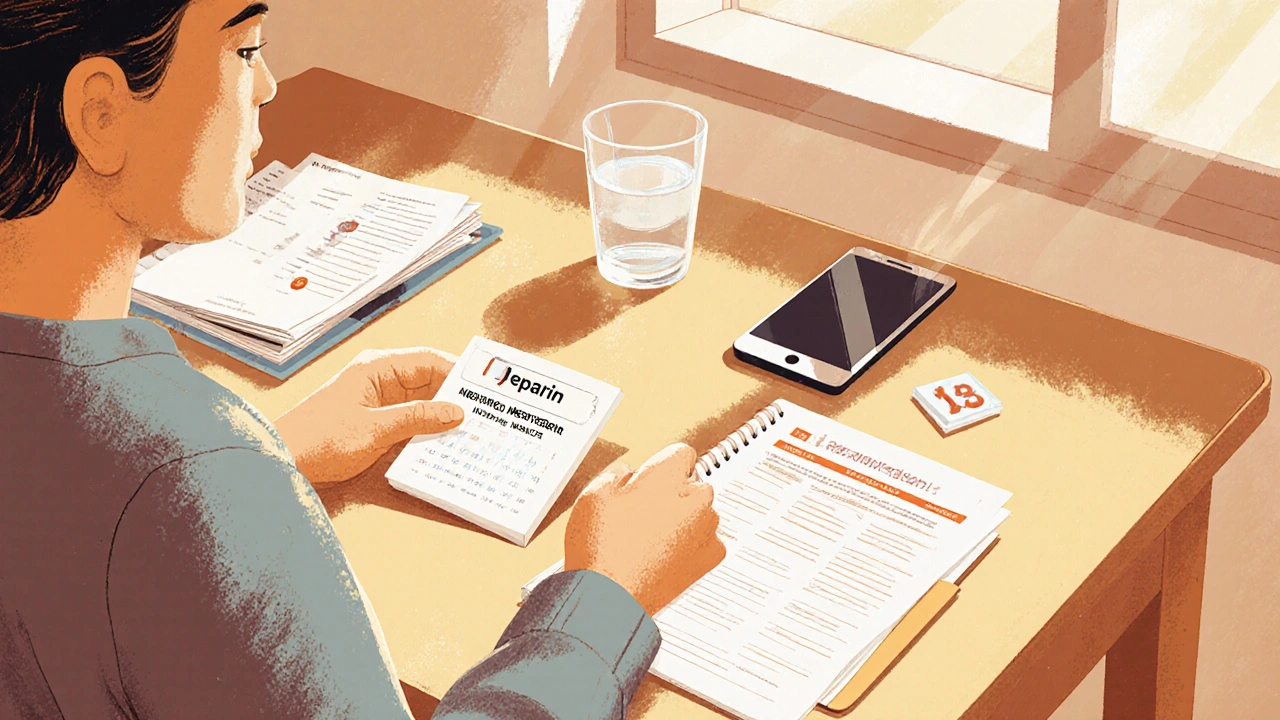Heparin Sodium Side Effects: Essential Guide for Patients

Heparin-Induced Thrombocytopenia (HIT) Risk Assessment
This tool helps you understand your personal risk of developing Heparin-Induced Thrombocytopenia (HIT), a rare but serious side effect of heparin therapy. Enter your information to get personalized risk assessment and guidance.
When your doctor prescribes a blood thinner, the first thing that pops into most people's heads is, "Will it make me bleed to death?" Understanding heparin sodium side effects helps you stay alert without living in fear. This guide walks you through what the drug does, the range of reactions you might notice, and practical steps to keep the risks under control.
What Is Heparin Sodium?
Heparin sodium is a highly purified, injectable anticoagulant that works by accelerating the activity of antithrombin III, a natural protein that deactivates clot‑forming enzymes such as thrombin and factor Xa. First isolated from animal tissue in the 1920s, it quickly became a staple in hospitals for preventing and treating blood clots during surgery, dialysis, and acute coronary events.
How Heparin Works - The Anticoagulant Effect
Heparin belongs to the broad class of Anticoagulant medications. By binding to antithrombin III, it dramatically speeds up the inhibition of clotting factors, slowing the formation of fibrin strands that lock red blood cells together. This mechanism is fast‑acting, which is why clinicians can adjust its effect within minutes using blood‑test feedback.
Common (Mild) Side Effects
- Minor bruising or pinpoint bleeding at the injection site.
- Redness or mild swelling where the needle entered.
- Transient low‑grade fever, usually gone within 24‑48 hours.
- Occasional nausea or a metallic taste.
These reactions are generally harmless and resolve on their own. Still, noting them in a diary can help your care team spot trends early.

Serious Adverse Reactions You Must Watch For
The rare but dangerous effects are where vigilance pays off.
- Heparin-induced thrombocytopenia (HIT) - an immune response that drops platelet counts dramatically and paradoxically increases clot risk. Look for sudden bruising, skin necrosis, or dark spots on the limbs.
- Major internal bleeding - indicated by black stools, vomiting blood, or unexplained dizziness.
- Allergic reactions - hives, swelling of the face or throat, and difficulty breathing.
- Spontaneous spinal or epidural hematoma - rare but possible after spinal anesthesia.
If any of these pop up, seek emergency care immediately.
Factors That Influence Side Effects
Not everyone reacts the same way. Several variables shape how you experience heparin:
- Dosage and infusion rate - higher doses increase bleeding risk.
- Route of administration - intravenous (IV) gives quicker effect but may cause more systemic reactions than subcutaneous (SC) injections.
- Kidney function - impaired clearance can let the drug linger, raising toxicity.
- Age and weight - older or low‑weight patients often need lower doses.
- Concurrent medications - drugs like aspirin, clopidogrel, or newer oral anticoagulants can amplify bleeding.
Monitoring and Managing Risks
Because heparin’s effect can swing quickly, clinicians rely on lab tests to keep you in the therapeutic window.
- Activated partial thromboplastin time (aPTT) - the primary test for unfractionated heparin; target range usually 1.5‑2.5× the normal value.
- Prothrombin time (PT) and International Normalized Ratio (INR) - more relevant for warfarin but occasionally checked when switching anticoagulants.
- Platelet count - done every 2‑3 days to catch HIT early.
If labs drift outside the target range, the care team will adjust the infusion rate or switch to a Low Molecular Weight Heparin (LMWH) like enoxaparin, which has a more predictable profile.

Comparison with Other Anticoagulants
| Feature | Heparin Sodium (unfractionated) | Low Molecular Weight Heparin (LMWH) | Warfarin | Dabigatran (direct thrombin inhibitor) |
|---|---|---|---|---|
| Administration | IV or SC (continuous) | SC (once‑ or twice‑daily) | Oral | Oral |
| Onset of action | Minutes | Hours | 48‑72 hrs | 30‑60 mins |
| Monitoring | aPTT needed | Usually none (anti‑Xa if needed) | INR required | No routine labs |
| Reversal agent | Protamine sulfate | Partial (protamine works partially) | Vitamin K | Idarucizumab (specific) |
| Risk of HIT | Higher (up to 5%) | Lower (<1%) | None | None |
Choosing the right anticoagulant depends on your medical history, procedure type, and how closely you can follow lab monitoring. Heparin remains the go‑to for short‑term, high‑risk scenarios where rapid reversal is essential.
Practical Tips for Patients on Heparin
- Carry a card that lists "Heparin sodium" and your current dose.
- Avoid activities with a high fall risk while on therapy, especially if you have a recent IV line.
- Report any unexpected bruising, blood in urine or stool, or prolonged nosebleeds immediately.
- Do not take over‑the‑counter NSAIDs (ibuprofen, naproxen) without checking with your clinician.
- Stay hydrated and maintain a balanced diet; dehydration can concentrate the drug and increase bleeding.
- Schedule regular lab appointments; missing a single aPTT check can delay dose adjustments.
By staying informed and proactive, you dramatically lower the chance that a side effect turns into a serious event.
Frequently Asked Questions
Can I take heparin with aspirin?
Combining heparin with aspirin raises bleeding risk, especially gastrointestinal bleeding. Your doctor may adjust the heparin dose or monitor you more closely if both are needed.
What is the typical duration of heparin therapy?
For surgical prophylaxis, heparin is often given for 24‑48 hours. In treatment of acute clots, it may continue for 5‑10 days before switching to an oral anticoagulant.
How is HIT diagnosed?
A sudden drop in platelet count (usually >50% from baseline) occurring 5‑14 days after starting heparin, coupled with a positive PF4‑heparin antibody test, confirms HIT.
Is it safe to have a dental cleaning while on heparin?
Minor dental procedures are generally safe, but inform the dentist about the heparin infusion. They may want to check your aPTT beforehand and apply pressure to any bleeding sites.
What should I do if I miss a dose?
Contact your healthcare provider right away. They will advise whether to give the missed dose or adjust the infusion schedule to avoid over‑anticoagulation.
Understanding the spectrum of heparin sodium side effects empowers you to collaborate confidently with your medical team. Stay alert, keep your labs up to date, and never hesitate to ask questions-your safety depends on it.
Heparin can cause bruising, so keep an eye on the injection site.
Stay on top of your labs, buddy. If your aPTT drifts, tell the nurse right away. Adjusting the drip early stops big bleeding. Keep a daily log, it'll save you stress.
From a pharmacokinetic perspective, unfractionated heparin exhibits a biphasic clearance mediated by endothelial uptake and renal excretion. Consequently, patients with reduced glomerular filtration rate exhibit prolonged half‑life, necessitating more frequent aPTT monitoring. Moreover, the dose‑response curve is nonlinear, so mg/kg calculations must account for lean body mass to mitigate HIT risk. Incorporating anti‑Xa assays can refine therapeutic windows when concurrent antiplatelet agents are present.
Oh my god, the thought of bleeding inside my body is a nightmare! I saw a friend get a massive hematoma after a simple line and it was pure horror. The whole hospital smelled like antiseptic fear. Every little bruise feels like a ticking time bomb. I can’t stand the idea of a hidden internal bleed, it haunts my dreams!
Honestly, most patients overreact to minor bruises; the guide underplays that the majority of side effects are trivial and self‑limiting.
The pharma industry hides the true danger of heparin with glossy brochures.
They fund the very labs that set the aPTT standards, creating a conflict of interest.
Every batch is blended with animal tissues, exposing patients to hidden zoonotic proteins.
The monitoring protocols were designed to keep you dependent on hospitals.
If you start noticing unexplained bruises, they will tell you it's normal and you’ll stay quiet.
The reversal agent protamine is stockpiled for emergencies, but its side effects are rarely disclosed.
The risk of HIT is downplayed, yet it accounts for a significant fraction of postoperative thromboses.
Independent studies show that low molecular weight heparins have a safer profile, but they are patented and more profitable.
The FDA’s advisory panels are populated by former executives of the manufacturers.
The guidelines promote continuous infusions, which maximize the drug’s market share.
Patients who keep meticulous diaries are often dismissed as hypochondriacs.
The black stool warning is a scare tactic to push you into urgent care where extra fees are generated.
In truth, many clinicians rely on outdated assays because newer technologies threaten their billing.
The whole system incentivizes over‑monitoring, keeping the drug’s revenue stream alive.
Stay skeptical, question every lab value, and demand transparent data from your care team.
I once had to call my mom at 3 am because my platelets dropped and I was freaking out.
Experiencing a sudden platelet dip can feel like confronting mortality; reflecting on it helps you regain control.
Indeed, maintaining composure during thrombocytopenic events is essential; systematic assessment of risk factors and prompt communication with the hematology team are recommended.
While laypersons obsess over superficial bruising, the nuanced interplay between antithrombin activation and factor Xa inhibition remains the cornerstone of anticoagulant pharmacodynamics.
Monitor labs, watch for bleeding.
Keep a bleeding diary; note any nosebleeds, gums, or unexpected bruises 😊. Share it with your clinician during each visit for precise dose tweaks.